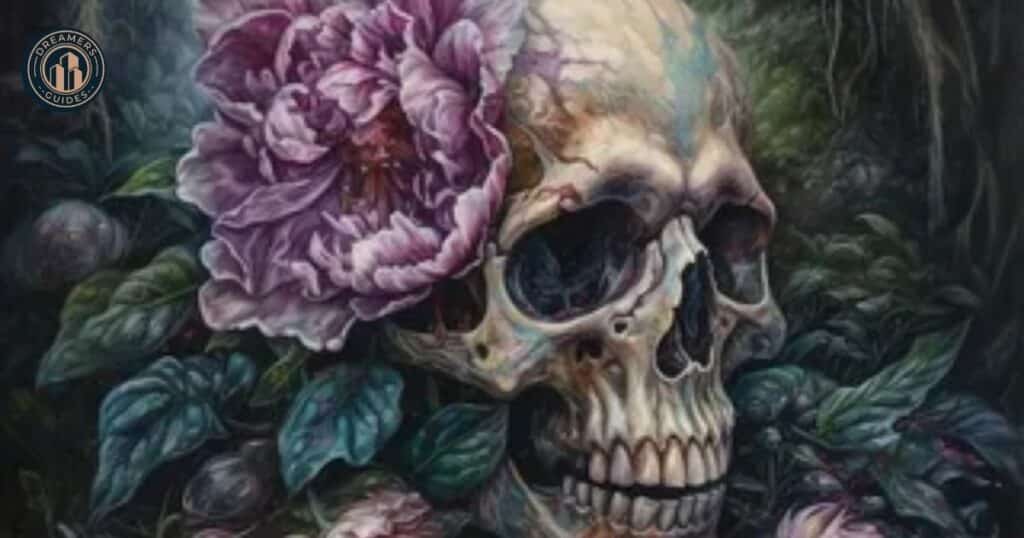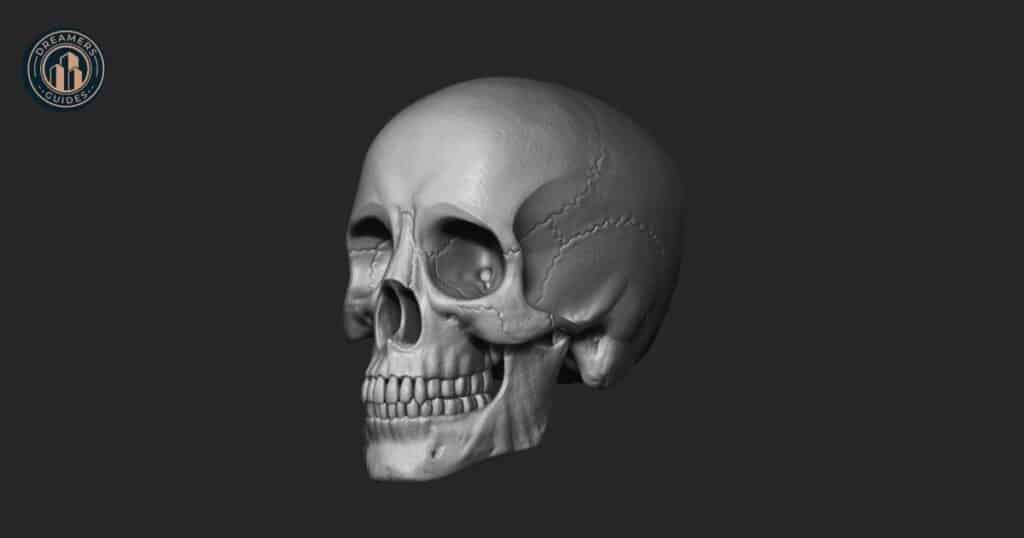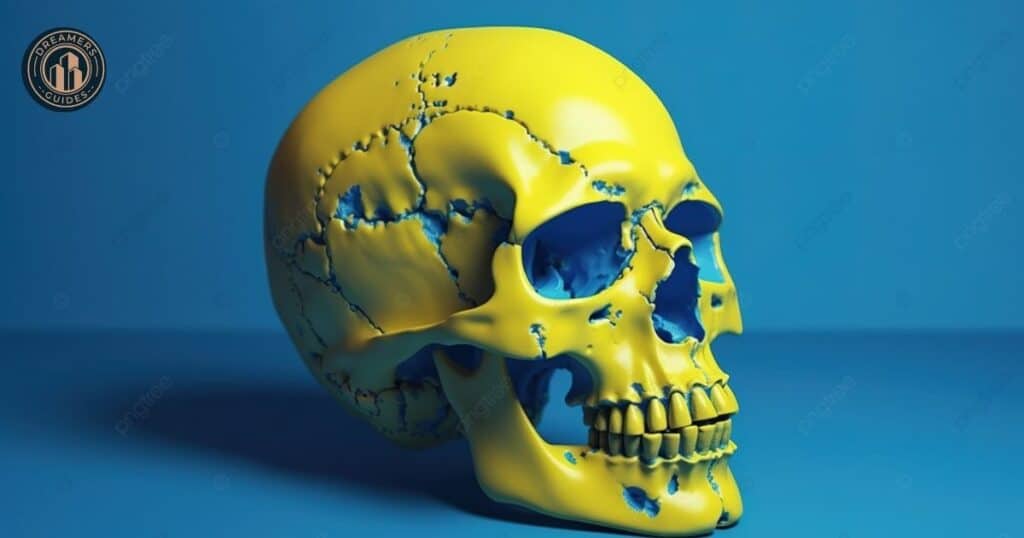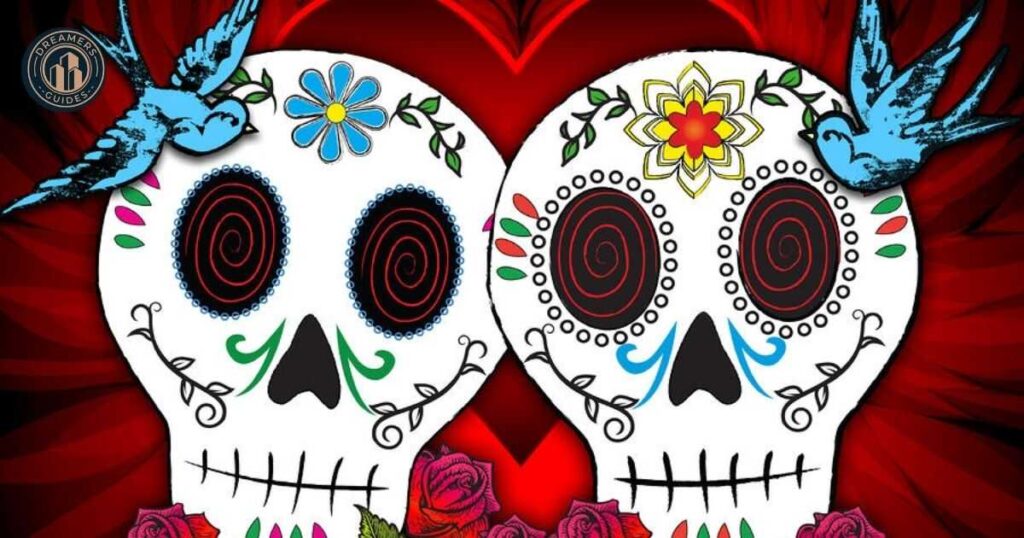Have you ever wondered what does the skull symbol mean across different cultures? From ancient civilizations to modern fashion, skulls have fascinated humans throughout history. They’re not just symbols of death they represent power, transformation, and even celebration in some traditions.
In Mexican culture, for example, sugar skulls (calaveras de azúcar) are crafted for Day of the Dead (Día de los Muertos), a joyful celebration honoring deceased loved ones. The skull reminds us of our mortality and acts as a “Memento Mori” symbol, urging us to embrace life’s fragility and impermanence.
In other contexts, skulls represent rebellion and danger. The Jolly Roger flag in pirate lore, for instance, signals a merciless attack, while biker culture and punk movements embrace skulls to symbolize nonconformity and defiance against societal norms.
Skull imagery also appears in spiritual traditions like Hindu Tantra, where skulls serve as symbols of spiritual growth and esoteric practices.To explore what does the skull symbol mean, we must consider its historical and contemporary interpretations.
Whether in Gothic literature or Vanitas paintings, skulls provoke deep existential contemplation about life, death, and what lies beyond. This enduring symbol of human fragility speaks to diverse emotions and philosophies, linking past to present across cultures and philosophies.
What Does the 💀 Skull Emoji Mean?
The skull emoji has evolved far beyond its original meaning of death or danger. Today’s digital natives often use it to express everything from laughter (“I’m dead 💀”) to amazement. In social media culture, this symbol has taken on a lighter tone, though it still carries deeper meaning in serious contexts.
Gen Z has particularly embraced the skull emoji as a way to express extreme emotions. When something’s hilarious, you might see comments filled with skull emojis meaning the content was so funny, it “killed” them. This shows how mortality symbols can transform over time.
Popular Skull Symbolism Around The World
The meaning of skull symbols varies dramatically across cultures. In some societies, they represent death symbolism and fear, while others see them as guardians of spiritual protection. Understanding these differences helps us appreciate the rich tapestry of human beliefs.

From the Aztec skull symbolism to modern tattoo culture, skulls continue to captivate our imagination. Their universal recognition makes them powerful symbols for expressing complex ideas about life, death, and everything in between.
Mortality
The concept of mortality stands at the heart of skull symbolism. When we see a skull, it serves as a poignant reminder of our own finite existence. This imagery, though unsettling to some, isn’t always frightening; many cultures embrace this reminder as motivation to live fuller, more meaningful lives.
The awareness of our transient life encourages individuals to seek purpose and fulfillment, aligning their actions with their values and relationships.
The tradition of Memento Mori (“remember you must die”) emerged in medieval Europe, encapsulating a philosophical reflection on life’s temporary nature. This phrase served as a powerful reminder that life is fleeting, inspiring people to appreciate each moment.
Artists and philosophers, particularly during the Renaissance, utilized skull imagery in their works to provoke contemplation about what truly matters in life. They juxtaposed skulls with symbols of beauty and wealth in Vanitas paintings, reinforcing the idea that material possessions are ultimately meaningless in the face of death.
Day of the Dead
In various cultures, such as during the Day of the Dead (Día de los Muertos) in Mexico, skulls take on a vibrant significance, symbolizing not only death but also the celebration of life.
Sugar skulls (calaveras de azúcar) are crafted as colorful tributes to deceased loved ones, serving as a reminder of the connection between the living and the dead. This tradition underscores the belief that acknowledging our mortality can enrich our understanding of life, making us more appreciative of our experiences.
Additionally, the existential contemplation prompted by skull symbolism encourages individuals to confront their fears and insecurities regarding death. It challenges us to consider our legacy, the impact we leave behind, and the ways we choose to honor our shared humanity.
Ultimately, the symbolism of the skull invites a deeper engagement with life’s impermanence, urging us to reflect on our values, pursue spiritual growth, and embrace the rich tapestry of existence.
Power
Throughout history, skulls have represented power in various forms, serving as a potent symbol across cultures. In ancient civilizations, warriors displayed enemy skulls as trophies, signifying their dominance in battle. This practice not only showcased their bravery but also served as a stark reminder of the consequences of defiance.
Even in modern military contexts, skull imagery is incorporated into insignias and unit patches to convey strength, fearlessness, and the ability to conquer adversaries. This enduring association underscores the skull’s role as a harbinger of power.
One of the most intriguing examples of skull symbolism connecting to power in modern times is the Skull and Bones society at Yale University. This secret society, founded in 1832, employs skull imagery to represent both their exclusivity and influence, reflecting how ancient symbols adapt to contemporary contexts.
The society’s rituals and the aura of secrecy surrounding it have cultivated a perception of significant societal power, suggesting that those who gain membership are endowed with formidable connections and opportunities.
The adaptation of skull symbolism in various formsbe it through rebel art movements, the punk scene, or even the biker cultureillustrates its resonance as an emblem of defiance and strength.
The incorporation of skulls into the aesthetics of the Hells Angels and similar organizations emphasizes their rejection of societal norms while simultaneously asserting their power and identity.
Ultimately, the symbolic representation of skulls has transcended time and culture. It has evolved from primal trophies of victory to complex emblems of influence and status in today’s society. The skull connects deeply to themes of mortality, transformation, and rebellion.
It serves as a reminder of the intricate relationship between life, death, and the power dynamics that shape our existence.
Read More About : Mars in Cancer: The Gardener and Homemaker
Secrecy
Secrecy and skull symbolism often go hand in hand. Secret societies throughout history have used skull imagery to represent hidden knowledge and exclusive membership, creating an air of mystery and power around their organizations.
The Skull and Bones society at Yale University, for instance, is known for its use of the skull motif to convey secrecy and the allure of privileged insight. Here, the skull is not merely a reminder of mortality but a potent symbol of secrecy and esoteric practices.

These symbols often represent both the promise of special knowledge and an elevated status. Members are granted access to sacred mysteries and exclusive intellectual and social networks that reinforce their powerful connections outside the organization.
The skull imagery serves as a guardian of secrets a visual warning to outsiders while providing a reassuring reminder to initiates of their elite membership. This dual symbolism of secrecy and power has cemented the skull as a lasting icon within secret societies.
It intertwines the quest for spiritual growth and hidden wisdom with the concept of an exclusive few possessing privileged knowledge.
Transformation
In many spiritual traditions, skulls represent transformation and spiritual growth. The Hindu goddess Kali wears a mundamala (skull garland), symbolizing the cycle of birth, death, and rebirth.
This connection to life after death appears in various forms across cultures. The skull becomes not just a symbol of ending, but of new beginnings and spiritual evolution.
Rebellion
The symbol of the skull in rebellion emerged strongly in biker culture and punk skull symbolism. During the 1950s and 60s, motorcycle clubs adopted skull imagery to express their defiance against mainstream society.
This bold statement of nonconformity helped establish skulls as powerful symbols of counter culture movements. To explore what does the skull symbol mean, we must consider its historical and contemporary interpretations.

Today, rebellion and skulls continue their close association in fashion, music, and art. From studded leather jackets to intricate skull tattoo meanings, these symbols express individuality and resistance to societal norms. Modern rebels use skull imagery to challenge conventional thinking and express their unique perspectives.
Evil
The connection between skulls and evil finds its most famous expression in the Jolly Roger flag. Pirates used this skull-and-crossbones design to strike fear into their victims’ hearts, making it one of history’s most recognizable symbols of destruction and evil.
However, the association of skulls with evil isn’t universal. While Western culture often connects skulls with villains and darkness, other traditions see them as protective symbols. This duality shows how cultural context shapes our interpretation of symbols.
Transience Of Life
The concept of transience life finds powerful expression in Vanitas paintings, where artists placed skulls alongside symbols of wealth and beauty. These artworks remind viewers about life’s temporary nature, encouraging existential contemplation about what truly matters.
The skull in these contexts represents human fragility and the fleeting nature of worldly pleasures. This theme appears in countless works of art and literature. It includes Shakespeare’s famous scene with Yorick’s skull in Hamlet, where the prince contemplates mortality through his childhood jester’s remains.
Read More About : Snake Symbolism Across Cultures and History
Danger
As a warning symbol, the skull has become universally recognized. Its use in everything from poison labels to high-voltage warnings demonstrates its effectiveness in communicating danger across language barriers.

Modern safety protocols rely heavily on skull imagery to prevent accidents and protect lives. This practical application shows how ancient symbols can serve vital contemporary purposes while maintaining their powerful impact on human psychology.
Skull Symbolism In Literature
In Gothic literature, skulls play a crucial role in creating atmosphere and exploring themes of mortality. Authors use skull imagery to delve into questions about life, death, and the supernatural, creating some of literature’s most memorable scenes.

Writers like Edgar Allan Poe and Mary Shelley masterfully incorporated skull symbolism to explore philosophical reflection and existentialism and death. Their works continue to influence how we use skull imagery in modern storytelling.
Skull Symbolism In Art
The tradition of symbolic art involving skulls reaches its peak in Vanitas paintings of the Renaissance period. Whether worn as a bold fashion statement or a meaningful accessory, skull jewelry evolves in meaning and design. Wearing these striking pieces allows individuals to honor the past.
At the same time, they redefine what these timeless symbols represent today. This transformation turns them into personal expressions of style and identity. Many people wonder what does the skull symbol mean in the context of art and fashion.
In this genre, artists sought to convey themes of existential contemplation and the transience of life. The juxtaposition of skulls with beautiful items highlights the idea that material wealth and physical beauty are ultimately meaningless in the face of mortality.
Notable artists, including Paul Cézanne and Pablo Picasso, later drew inspiration from the skull motif, further enriching its symbolic significance in modern art. This enduring fascination reflects society’s continuous grappling with death, rebellion, and the human experience.
Incorporating skulls into art serves as a cautionary reminder of our mortality and an invitation to embrace the vibrant essence of life. This theme is celebrated worldwide, including the colorful sugar skulls of the Day of the Dead.
| Period | Artistic Movement | Key Symbolism |
| Medieval | Memento Mori | Religious reflection |
| Renaissance | Vanitas | Life’s brevity |
| Modern | Street Art | Social commentary |
| Contemporary | Digital Art | Cultural fusion |
Skulls Symbolism In Politics
Throughout history, skulls have represented social revolution and political change. Revolutionary movements often adopted skull imagery to symbolize their willingness to die for their cause and to challenge existing power structures.
Political cartoonists and artists continue to use skull symbolism to critique power and corruption. This demonstrates how ancient symbols can serve modern political discourse while maintaining their emotional impact.
Skulls In Mexican Cultures
The celebration of Day of the Dead (Día de los Muertos) represents a uniquely positive interpretation of skull symbolism. During this festival, sugar skulls (calaveras de azúcar) become symbols of honor and remembrance rather than fear or sadness.

Mexican folk art embraces skull imagery through colorful designs and intricate patterns. This cultural tradition shows how skulls can represent celebration and connection rather than just loss and mourning. In different traditions, what does the skull symbol mean often relates to themes of mortality and rebirth.
Read More About :Everything You Need About Mars in Aries: The Fiery Warrior
Skulls: What They Represent About Men’s & Women’s Jewelry Today
Modern jewelry designers have transformed skull symbols into powerful fashion statements. This resurgence of skull imagery in contemporary jewelry reflects a growing trend.
Where ancient motifs are reinterpreted through a modern lens. By merging traditional mortality symbols with innovative designs, these pieces create unique expressions of personal identity that resonate with wearers on multiple levels.
The Evolving Meaning of Skull Jewelry
The popularity of skull jewelry demonstrates how ancient symbols can adapt to modern tastes while maintaining their deeper meanings. Historically, skulls have represented mortality, power, and transformation across various cultures.
Today, these meanings remain relevant, allowing individuals to connect with the rich symbolism of skulls while showcasing their personal style. Many people wear jewelry featuring skull symbolism as a reminder to embrace each moment.
For many, wearing skull jewelry serves as a personal talisman, a reminder of life’s transience and the importance of embracing each moment. By choosing pieces adorned with skull motifs, individuals are not just making a fashion statement.
They are engaging in a form of existential contemplation, reflecting on the impermanence of life and the philosophical significance of death. Understanding what does the skull symbol mean can provide insight into its significance in various cultures.
Skull Symbols in Fashion and Subcultures
Skull jewelry is particularly prominent in subcultures such as punk and biker communities, where it symbolizes rebellion and nonconformity. In these circles, skulls are often seen as a badge of honor, representing a fearless attitude towards life and danger.
The adoption of skull imagery in biker culture speaks to the thrill of the open road and a shared sense of camaraderie among riders.
Furthermore, the rise of gothic fashion has propelled skull symbols into mainstream culture. Gothic jewelry often features intricate designs that play on themes of death, destruction, and evil, making skulls an emblem of the macabre.
These pieces appeal to those who appreciate the aesthetics of the darker side of life while also embracing the deeper, symbolic meanings behind skull imagery.
Celebrating Individuality
Today, skull jewelry is no longer confined to the realms of subculture; it has been embraced by high-fashion designers and mainstream consumers alike. This evolution highlights the versatility of skulls as symbols.
They can convey a sense of strength, spiritual protection, or even a celebration of life itself, as seen in Mexican folk art and the Day of the Dead celebrations. Skull symbolism varies widely across cultures, representing everything from mortality to transformation.
Whether worn as a bold fashion statement or a meaningful accessory, skull jewelry continues to evolve in meaning and design. By wearing these striking pieces, individuals honor the past while redefining what these timeless symbols represent today. This transformation turns them into personal expressions of style and identity.
The popularity of skull jewelry demonstrates how ancient symbols can adapt to modern tastes while maintaining their deeper meanings. Whether worn as a fashion statement or a personal talisman, skull jewelry continues to evolve in meaning and design.
| Jewelry Type | Common Meaning | Popular Styles |
| Rings | Personal power | Gothic, Biker |
| Necklaces | Protection | Minimalist, Ornate |
| Bracelets | Rebellion | Modern, Traditional |
| Earrings | Fashion statement | Subtle, Bold |
Read More About : Butterfly Meaning, Symbolism & Significance in World Culture
Conclusion
Understanding what does the skull symbol mean reveals the rich complexity of human symbolism. From ancient sacred skull relics to modern emoji usage, skulls continue to evolve in meaning while maintaining their power to provoke thought and emotion.
The endurance of skull symbolism across cultures and time periods demonstrates its fundamental connection to human experience. Whether representing mortality, transformation, or celebration, skulls remain powerful symbols in our collective consciousness.
As we reinterpret ancient symbols for modern times, they convey complex ideas about life and death. The skull’s evolution from a symbol of mortality to a multifaceted cultural icon illustrates how human symbolism adapts. Despite these changes, it retains its core power to move and inspire us.

James Michael
James Michael is the creative force behind Dreamers Guides, dedicated to exploring the rich symbolism and spirituality of diverse cultures. With a passion for uncovering ancient wisdom, He crafts insightful narratives that connect beliefs and foster understanding among readers worldwide.